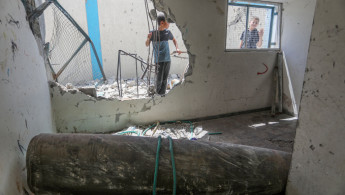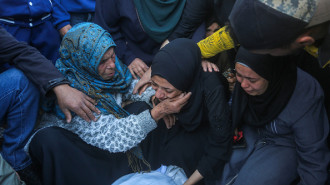Unexploded Israeli ordnances: a hidden death awaits the displaced in Gaza
In front of a group of displaced children in Deir al-Balah camp in the central Gaza Strip, Hind Abu Daqqa, 38, climbs onto a wooden platform to present a theatre production for children.
In the show, Daqqa plays the role of a little girl wandering through the rubble of destroyed homes in search of her lost toy, and suddenly fell to the ground pretending to have been killed.
Abu Daqqa, who works at the Tamer Foundation for Childhood, which seeks through this show to educate children about the dangers of playing with unidentified objects and unexploded ordnance and to tell adults if they find anything.
"One day this war will stop, but death will not stop because of these munitions stuck in the rubble of homes," Abu Daqqa told The New Arab.
Hidden death
Unexploded ordnance is one of the most dangerous threats facing the residents of the Gaza Strip, who are eagerly awaiting the return to their damaged homes and neighbourhoods after the withdrawal of the Israel's army.
Explosive remnants of war (REG) are munitions that failed to explode due to technical failure or other reasons and were left on the battlefield, possibly even deliberately with the intent to kill.
According to UN estimates, two-thirds of buildings in the Gaza Strip have been damaged, highlighting the risks that await displaced people once the war ends, particularly in dealing with unexploded ordnance.
In the city of Khan Younis in the southern Gaza Strip, Yasser Sahmoud, 49, returned to his destroyed home, hoping to retrieve some clothes for his children that they had left behind from the rubble.
When he arrived in his neighbourhood, the destruction was evident in every corner, and the streets were covered in debris. Sahmoud walked cautiously through the rubble, searching for any trace of his shattered past.
As Sahmoud bent down to pick up a small shirt for his child, he did not know that his foot was resting on a landmine hidden among the rubble. One moment was enough to change the course of his life.
"At one point, my body flew in the air before I fell to the ground. I saw blood flowing from me until I discovered that my leg had been amputated," he said to TNA. "I screamed with all my might before I lost consciousness, until I woke up and found myself on a hospital bed without a leg."
"I don't know how I will provide for my children now that I lost my leg. How will I practice my profession as a construction worker while I am in this condition?" he added, his words filled with pain.
14 years to clear up
On the sidelines of the 30th edition of the "Shoe Pyramid" event organised by Handicap International, an annual event held to raise public awareness about the damage caused by bombs and mines to civilians, the organisation warned that unexploded ordnance is one of the biggest long-term problems in Gaza.
AFP quoted Anne Hery, the director of Advocacy and Institutional Relations at Handicap International, noting that unexploded ordnance includes rockets, artillery shells and cluster bombs.
According to Hery's estimates, the Israeli army has bombarded Gaza, which is considered one of the most densely populated areas in the world, with about 500 bombs a day.
An official in the Ministry of Interior in Gaza, who preferred to remain anonymous, remarked to TNA that the Israeli army has dropped more than 70,000 tons of explosives on the Gaza Strip since October 2023.
He further said that at least 10 percent of these explosives, or about 7,000 tons, have not exploded, which means that they are still a massive danger as they lie in wait among the rubble of destroyed homes in the Strip.
The official added that the remains of these explosives pose a major threat to anyone who approaches them or tries to touch them, noting that they continue to claim lives even after the fighting has stopped, and hinder the return of displaced people to their homes.
He also stressed that the danger increases in areas where the Israeli army has deliberately detonated landmines, as many of these mines have not exploded and remain active under the rubble.
The official pointed out that the high population density in Gaza and the narrow geographical area make it difficult to evacuate civilians to safe areas, explaining that the sector lacks public spaces or safe areas that can accommodate this large number of residents.
On 12 August, the Washington Institute for Near East Policy published an analysis prepared by Andrew J. Clemmensen, the institute's military fellow for 2023-2024 and a colonel in the US Air Force, in which he revealed that the reconstruction of the Gaza Strip will not be possible before removing thousands of unexploded bombs and explosive materials that fill the urban rubble.
He pointed out that this vital mission suffers from a severe shortage of funding and specialised personnel.
The analysis warned that these war remnants could lead to hundreds, and perhaps thousands, of casualties, even after the fighting ends.
On 2 May 2024, the United Nations Mine Action Service said that about 7,500 tons of unexploded ordnance are scattered throughout the Gaza Strip as a result of the ongoing Israeli war, and that removing them will take about 14 years.




 Follow the Middle East's top stories in English at The New Arab on Google News
Follow the Middle East's top stories in English at The New Arab on Google News

![A group of Palestinians, foreign and Israeli activists gather to participated in an olive picking event on the land in the town of Battir, which is under threat of confiscation by Israel in Bethlehem, occupied West Bank on 8 November 2024. [Getty]](/sites/default/files/styles/image_330x185/public/2182930803.jpeg?h=199d8c1f&itok=__0LgGsa)
